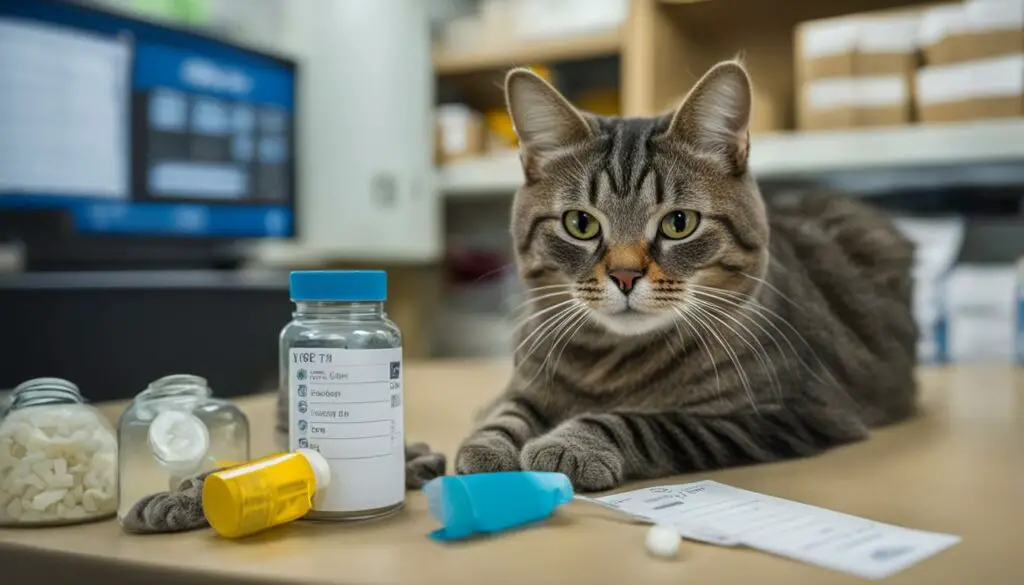Bladder stones and crystals can be a serious health concern for cats, potentially leading to urinary blockage, a life-threatening condition. If your cat has been diagnosed with bladder stones, it’s important to understand the cost associated with their surgical removal.
Bladder stones can vary in type, size, and location, which can impact the overall cost of surgery. Factors such as the type of stone, the complexity of the procedure, and the specific treatment approach recommended by your veterinarian can all contribute to the final cost.
While the cost of surgery can be significant, it’s important to prioritize your cat’s health and well-being. It’s essential to discuss the estimated cost with your veterinarian and inquire about available payment options or pet insurance coverage to ensure the best possible care for your furry friend.
Key Takeaways:
- The cost of cat bladder stone surgery can vary depending on factors such as stone type, size, and location.
- Bladder stones can be a serious health concern for cats, potentially leading to urinary blockage.
- Discuss the estimated cost of surgery with your veterinarian and inquire about payment options or pet insurance coverage.
- Prioritize your cat’s health and well-being when making decisions about their healthcare.
- Consider exploring affordable options, such as payment plans or financing, to manage the cost of bladder stone surgery.
What Are Bladder Stones and Crystals in Cat Urine?
Bladder stones and crystals are solid waste particles that form in the urine when waste products become concentrated enough to solidify. They can be found in the kidneys, bladder, or urethra, and can lead to signs of kidney disease or urinary blockage. Different types of stones and crystals can occur, including struvite, calcium oxalate, urate, xanthine, cystine, and silica.
The smallest particles first appear as crystals and can eventually become stones as big as the bladder itself. It is important to recognize the symptoms of bladder stones and crystals, such as increased urination, straining to urinate, blood in the urine, and urinating outside the litterbox. These symptoms may indicate the presence of bladder stones or crystals and should be evaluated by a veterinarian.
To illustrate the prevalence of bladder stones and crystals in cats, here is a breakdown of the percentage of cats affected by different types of stones:
| Type of Stone | Percentage of Cats Affected |
|---|---|
| Struvite | 45% |
| Calcium Oxalate | 30% |
| Urate | 10% |
| Xanthine | 5% |
| Cystine | 5% |
| Silica | 5% |
In conclusion, bladder stones and crystals in cat urine are solid waste particles that can cause urinary blockage and other urinary issues. Recognizing the symptoms and seeking veterinary attention promptly is crucial to ensure proper diagnosis and treatment. With the right treatment approach and long-term management, cats can live a healthy and comfortable life despite the presence of bladder stones and crystals.
The Difference Between Crystals and Bladder Stones
Crystals and bladder stones are related but have distinct characteristics. Crystals are the building blocks of bladder stones, forming when waste products in the urine become concentrated enough to solidify. They are smaller in size and may not cause noticeable symptoms on their own. On the other hand, bladder stones are larger, solid accumulations of crystals that can cause significant discomfort and urinary issues.
The main difference between crystals and bladder stones is their size and impact on a cat’s health. Crystals are microscopic and can be detected in urine samples under a microscope. They may not always require treatment unless they contribute to the formation of bladder stones or cause other complications. Bladder stones, on the other hand, can vary in size and may obstruct the flow of urine, leading to more severe symptoms and potential life-threatening conditions.
It is important to note that crystals and bladder stones can be made up of different substances, including struvite, calcium oxalate, urate, xanthine, cystine, and silica. The type of crystal or stone affects the treatment approach and long-term management strategies. Diagnostic tests such as bloodwork, urinalysis, and imaging are used to determine the type, size, and location of crystals or stones in the urinary tract.
| Crystals | Bladder Stones |
|---|---|
| Microscopic in size | Visible and larger in size |
| May not cause symptoms | Can cause urinary blockage and discomfort |
| Can be dissolved or managed with diet changes | May require surgical removal or other interventions |
| Building blocks of bladder stones | Form when crystals accumulate and solidify |
In summary, crystals and bladder stones differ in size, impact on a cat’s health, and the need for treatment. While crystals are microscopic and may not always cause symptoms, bladder stones are larger and can lead to urinary blockage and discomfort. Understanding the difference between crystals and bladder stones is crucial for effective diagnosis and management of urinary issues in cats.
Symptoms of Bladder Stones and Crystals in Cat Urine
Recognizing the symptoms of bladder stones and crystals in cat urine is crucial for early detection and prompt veterinary intervention. Cats experiencing these urinary issues may exhibit various signs that indicate a potential problem. Some common symptoms include:
- Increased frequency of urination: Cats with bladder stones or crystals may urinate more frequently than usual.
- Straining to urinate: Difficulty or discomfort while urinating is a common symptom of bladder stones and crystals.
- Blood in the urine: Visible blood or the presence of red-colored urine is an alarming sign that should not be ignored.
- Urinating outside the litterbox: Cats may exhibit inappropriate urination behavior, such as urinating outside their designated litterbox.
In more severe cases, cats with bladder stones and crystals may experience urinary blockage. This can be life-threatening and requires immediate veterinary attention. Additional symptoms of urinary blockage include:
- Inability to urinate: Complete obstruction of the urinary tract may prevent cats from urinating altogether.
- Lethargy: Cats may appear weak, tired, or lack energy.
- Vomiting: Nausea and vomiting may occur as a result of the blockage and associated discomfort.
- Lack of appetite: Cats may lose their interest in food and show a decreased appetite.
- Signs of pain: Cats may exhibit signs of discomfort, such as restlessness, vocalization, or sensitivity in the abdominal area.
It is important to note that these symptoms can vary in severity and may overlap with other medical conditions. If you notice any of these signs or suspect that your cat may have bladder stones or crystals, it is essential to consult a veterinarian for a proper diagnosis and appropriate treatment.

Causes of Bladder Stones and Crystals in Cat Urine
Bladder stones and crystals in cat urine can be caused by various factors, although the exact cause is still unknown. Understanding these causes can help in the prevention and management of this condition in cats. Some of the potential causes include:
- Breed: Certain breeds of cats, such as Persians and Siamese, may be more prone to developing bladder stones and crystals.
- Sex: Male cats are generally more likely to develop urinary blockages due to their narrower urethras.
- Age: Older cats are at a higher risk of developing bladder stones and crystals.
- Diet: A diet that is high in minerals and low in water content can contribute to the formation of bladder stones and crystals.
- Underlying health conditions: Cats with certain health conditions, such as urinary tract infections or metabolic disorders, may be more susceptible to developing bladder stones and crystals.
It is important to note that these causes can vary from cat to cat, and a combination of factors may contribute to the development of bladder stones and crystals.
By addressing these potential causes and making appropriate lifestyle and dietary adjustments, pet owners can help reduce the risk of bladder stones and crystals in their cats. Consulting with a veterinarian is crucial for a comprehensive evaluation and tailored recommendations for each individual cat.
| Cause | Description |
|---|---|
| Breed | Certain breeds, such as Persians and Siamese, may be more prone to bladder stones and crystals. |
| Sex | Male cats are at a higher risk of urinary blockages due to their narrower urethras. |
| Age | Older cats are more susceptible to developing bladder stones and crystals. |
| Diet | A diet high in minerals and low in water content can contribute to stone and crystal formation. |
| Underlying health conditions | Cats with urinary tract infections or metabolic disorders may be more prone to developing bladder stones and crystals. |
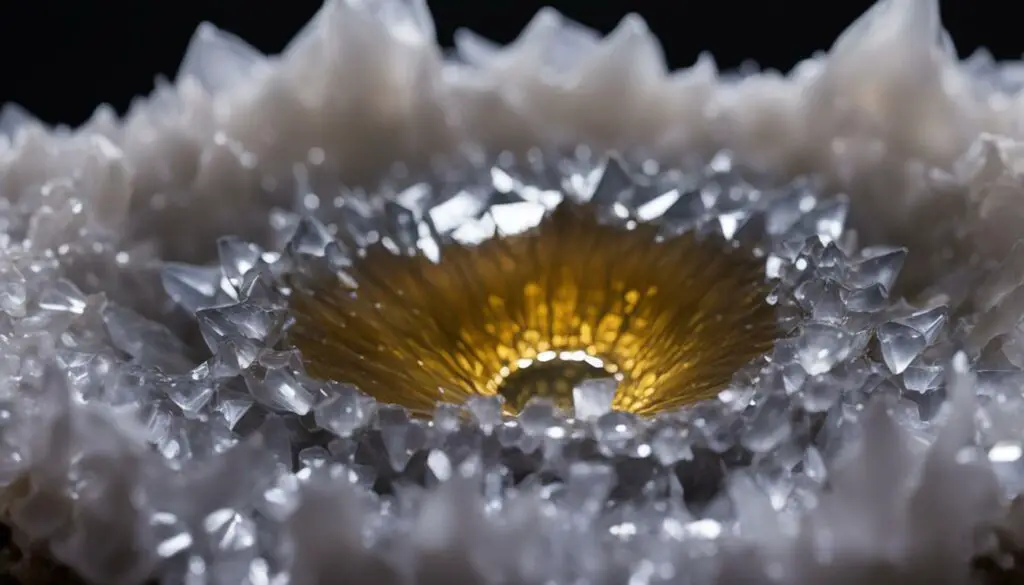
By addressing these potential causes and making appropriate lifestyle and dietary adjustments, pet owners can help reduce the risk of bladder stones and crystals in their cats. Consulting with a veterinarian is crucial for a comprehensive evaluation and tailored recommendations for each individual cat.
How Veterinarians Diagnose Bladder Stones and Crystals in Cat Urine
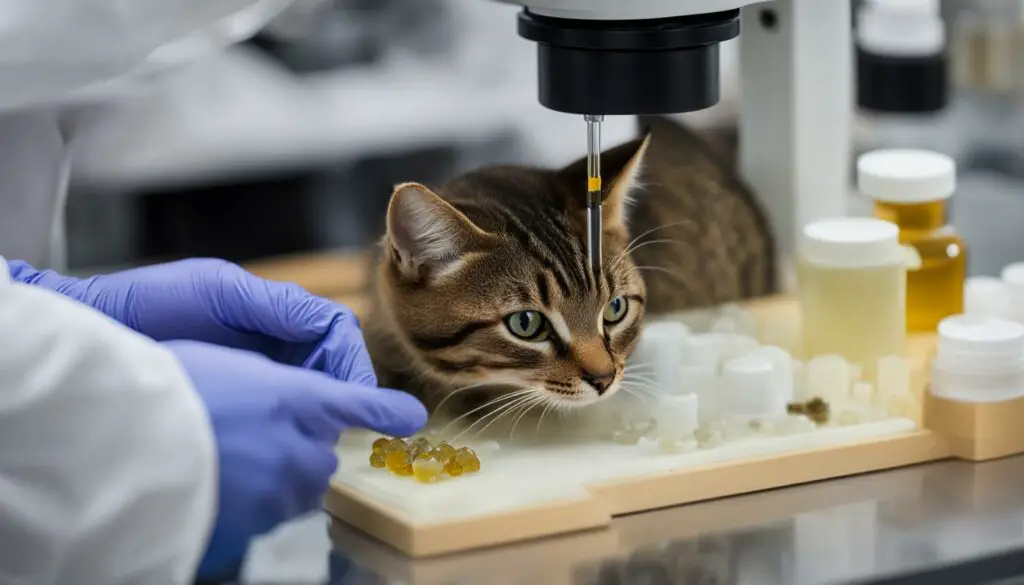
When it comes to diagnosing bladder stones and crystals in a cat’s urine, veterinarians rely on a combination of diagnostic tests to determine the type, size, and location of the stones. These tests are essential in guiding the appropriate treatment approach and ensuring the best possible outcome for the cat.
The first step in the diagnostic process is usually a comprehensive physical examination, during which the veterinarian examines the cat’s abdomen, palpates the bladder if necessary, and evaluates the overall health and wellbeing of the cat. Following the physical examination, the veterinarian may recommend several diagnostic tests to get a clearer picture of the bladder stones and crystals:
- Urinalysis: A urine sample is collected and analyzed to check for the presence of crystals, measure urine pH levels, and detect any signs of infection or inflammation.
- Bloodwork: A blood sample is taken to evaluate the cat’s kidney function, assess any underlying medical conditions, and determine the severity of the blockage caused by the stones.
- Imaging: X-rays or ultrasound imaging may be used to visualize the stones, their size, and their location within the urinary tract.
By combining the information obtained from these diagnostic tests, veterinarians can accurately diagnose bladder stones and crystals, determine the appropriate treatment approach, and provide the best possible care for the affected cat.
| Diagnostic Test | Purpose |
|---|---|
| Urinalysis | To check for crystals, measure urine pH, and detect any signs of infection or inflammation. |
| Bloodwork | To evaluate kidney function, assess underlying conditions, and determine the severity of blockage. |
| Imaging (X-rays or ultrasound) | To visualize the stones, determine their size, and locate their position within the urinary tract. |
Treatment of Bladder Stones and Crystals in Cat Urine
When it comes to treating bladder stones and crystals in cats, the approach varies depending on factors such as the type of stone, size, and location. Female cats may be able to pass small stones on their own, but male cats are at higher risk for urinary blockage and may require more extensive treatment. Treatment options can include prescription diets, medication, and surgical removal.
Prescription diets: Special prescription diets designed to dissolve or prevent the formation of certain types of stones can be used as a conservative management strategy. These diets work by creating a specific urine environment that discourages stone formation and promotes the dissolution of existing stones.
Medication: In some cases, medication may be prescribed to help manage bladder stones and crystals. Medications can help reduce inflammation, alleviate pain, prevent bacterial infections, and dissolve certain types of stones. However, medication alone may not be sufficient for larger stones or cases of urinary blockage.
Surgical removal: Surgical removal of bladder stones may be necessary, especially for larger stones or cases of urinary blockage. This procedure typically involves anesthesia, hospitalization, and post-operative care. The stones are surgically extracted from the bladder or urethra, allowing for the restoration of normal urinary function. In cases of urinary blockage, catheterization may be necessary to flush the stone back into the bladder before removal.
“Prompt and appropriate treatment is essential to prevent complications and restore normal urinary function.”
Table: Comparison of Treatment Options for Bladder Stones and Crystals in Cats
| Treatment Option | Description | Pros | Cons |
|---|---|---|---|
| Prescription diets | Special diets designed to dissolve or prevent stones | – Non-invasive – Can be used for long-term prevention |
– May take time to see results – Limited effectiveness for certain types of stones |
| Medication | Medication to manage symptoms and dissolve certain stones | – Can provide relief from pain and inflammation – Non-invasive |
– Limited effectiveness for larger stones or cases of urinary blockage – Potential side effects |
| Surgical removal | Extraction of stones through surgery | – Immediate removal of stones – Restores normal urinary function |
– Invasive procedure – Requires anesthesia and hospitalization – Potential risk of complications |
Each treatment option has its own advantages and considerations, and the best approach will depend on the specific circumstances and recommendations of the veterinarian. Prompt diagnosis and treatment are crucial to prevent complications and provide relief for cats suffering from bladder stones and crystals.
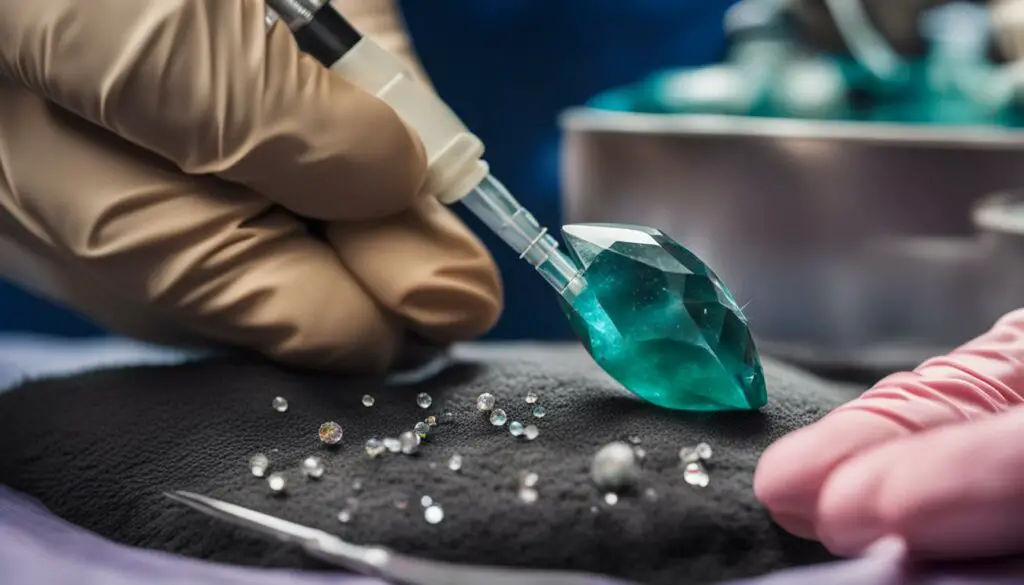
Recovery and Management of Bladder Stones and Crystals in Cat Urine
After undergoing treatment for bladder stones and crystals, it is essential to focus on the recovery and long-term management of your cat’s urinary health. This includes implementing lifestyle changes and monitoring their condition to prevent the recurrence of stones and crystals. The following strategies can help support your cat’s recovery and ensure their ongoing well-being:
- Prescription Diets: Your veterinarian may recommend a specialized diet tailored to your cat’s specific needs. These prescription diets are formulated to reduce the risk of crystal and stone formation by promoting urinary tract health and maintaining an optimal urine pH.
- Increased Water Intake: Encouraging your cat to drink more water is crucial to dilute urine and prevent its concentration, which can contribute to the formation of crystals and stones. Consider using a water fountain or adding water to their meals to promote hydration.
- Regular Check-ups: Schedule regular follow-up appointments with your veterinarian to monitor your cat’s urinary health. These visits may involve urinalysis to check for any signs of crystal formation or urinary tract infections.
It is important to note that every cat is unique, and the management approach may vary depending on their specific condition. Therefore, it is essential to follow your veterinarian’s recommendations and seek their guidance if any concerns or changes in your cat’s behavior occur. With proper care, attention, and ongoing management, you can help ensure your cat’s urinary health and minimize the risk of future bladder stones and crystals.
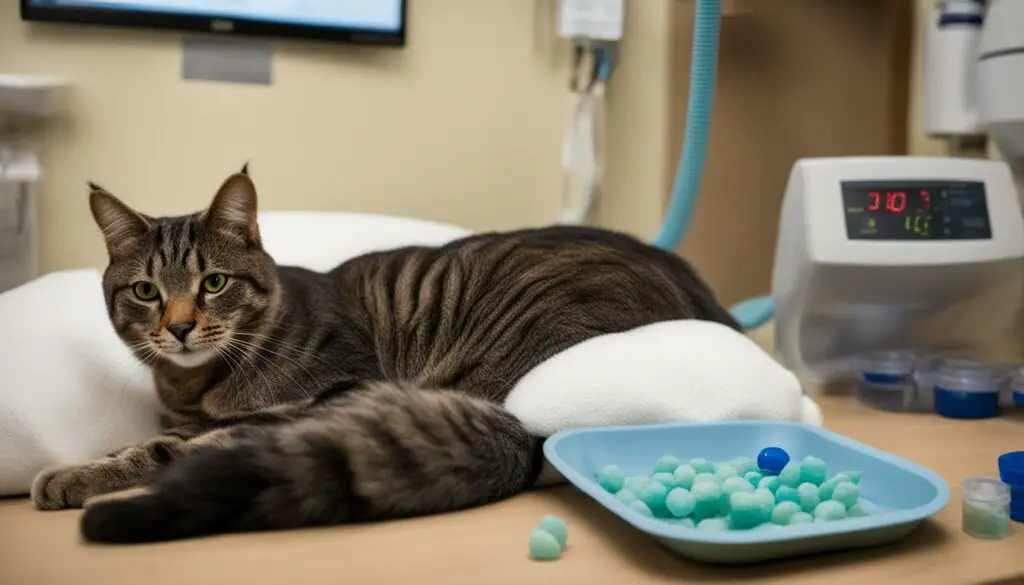
The Cost of Cat Bladder Stone Surgery: Understanding the Expenses
When it comes to the cost of cat bladder stone surgery, there are several factors that can influence the overall expenses. The specific type of stone, its size, and location can all impact the complexity of the procedure and, consequently, the cost. Additionally, the treatment approach recommended by the veterinarian, geographical location, and individual veterinary practice can also play a role in determining the final price.
On average, cat bladder stone surgery can range from several hundred to several thousand dollars. This includes pre-surgical consultations, diagnostic tests, surgical fees, anesthesia costs, medication, hospitalization, and follow-up visits. It is important for pet owners to have a clear understanding of these potential expenses and to discuss them with their veterinarian before proceeding with the surgery.
| Expense | Estimated Cost |
|---|---|
| Pre-surgical consultations | $100 – $200 |
| Diagnostic tests (bloodwork, urinalysis, imaging) | $200 – $500 |
| Surgical fees | $500 – $1,500 |
| Anesthesia costs | $100 – $300 |
| Medication | $50 – $200 |
| Hospitalization | $200 – $500 (per day) |
| Follow-up visits | $50 – $100 |
It’s important for pet owners to consider the potential financial implications of cat bladder stone surgery and to explore available payment options or pet insurance coverage. Some veterinary practices offer payment plans or financing options to help manage the expenses. Additionally, pet insurance can provide coverage for surgical procedures, including bladder stone removal. By discussing these options with their veterinarian, pet owners can ensure the best possible care for their cat while considering the financial aspect.

Average Cost of Cat Bladder Stone Surgery
When it comes to cat bladder stone surgery, the cost can vary depending on various factors. These factors include the type of stone, its size, location, and the complexity of the procedure. Additionally, the specific treatment approach recommended by the veterinarian and the geographic location of the veterinary practice can also influence the cost.

The average cost of cat bladder stone surgery typically ranges from several hundred to several thousand dollars. This cost includes pre-surgical consultations, diagnostic tests, surgical fees, anesthesia costs, medication, hospitalization, and follow-up visits. The specific type of stone and the complexity of the procedure can significantly impact the overall expenses.
It’s essential for pet owners to discuss the estimated cost with their veterinarian. This will help them make an informed decision regarding their cat’s healthcare while also considering the potential financial implications. It’s worth noting that some veterinary practices offer payment plans or financing options to help make the cost more manageable for pet owners.
| Treatment | Cost Range |
|---|---|
| Prescription Diets | $50 – $100 per month |
| Medication | $100 – $300 per month |
| Surgical Removal | $1,000 – $5,000 |
Treatment Costs Breakdown
- Prescription Diets: These diets are specially formulated to dissolve or prevent the formation of certain types of bladder stones. The cost can vary depending on the brand and specific dietary requirements of the cat.
- Medication: Some types of bladder stones may be treatable with medications. The cost of these medications can depend on the type of medication prescribed and the duration of treatment.
- Surgical Removal: For larger or more complicated bladder stones, surgical removal may be necessary. The cost of surgery can vary depending on the specific procedure performed and the veterinary practice.
In conclusion, the average cost of cat bladder stone surgery can vary depending on multiple factors. It’s important for pet owners to discuss the estimated cost with their veterinarian and explore potential payment options or pet insurance coverage. By understanding the potential expenses and considering affordable options, pet owners can provide the necessary care for their cat while managing the costs effectively.
Factors Affecting the Cost of Cat Bladder Stone Surgery
When it comes to cat bladder stone surgery, several factors can influence the overall cost of the procedure. Understanding these factors can help pet owners make informed decisions about their cat’s healthcare while considering the financial aspect.
One of the key factors is the type of stone that needs to be removed. Different types of stones may require different treatment approaches, which can vary in complexity and cost. Additionally, the size and location of the stones can also affect the overall expenses, as larger or harder-to-reach stones may require more extensive surgical procedures.
Another factor to consider is the specific treatment approach recommended by the veterinarian. Some cases may be treatable with non-invasive methods, such as prescription diets or medications, which can be more cost-effective compared to surgical removal. However, in more severe cases or instances of urinary blockage, surgical intervention may be necessary, leading to higher costs.
Geographical location can also play a role in the cost of cat bladder stone surgery. Veterinary services can vary in price depending on the region or city, so it’s important for pet owners to research local veterinary practices and compare prices to find the best option for their budget.
| Factors Affecting Cost of Cat Bladder Stone Surgery |
|---|
| Type of stone |
| Size and location of stones |
| Treatment approach recommended by veterinarian |
| Geographical location |

“Understanding the factors that can affect the cost of cat bladder stone surgery is essential for pet owners. By having a clear understanding of these factors and discussing potential expenses with their veterinarian, they can make informed decisions about their cat’s healthcare while considering their financial situation.”
Affordable Options for Cat Bladder Stone Surgery Cost
When it comes to cat bladder stone surgery, the cost can be a significant concern for pet owners. However, there are affordable options available to help manage the expenses without compromising your cat’s health. Some veterinary practices offer payment plans or financing options that allow you to spread out the cost over time, making it more manageable for your budget.
Additionally, pet insurance can provide coverage for surgical procedures, including bladder stone removal. It’s essential to review your pet insurance policy to understand what it covers and whether it includes coverage for bladder stone surgery. If you don’t have pet insurance, it’s worth considering as a way to protect your cat’s health and manage unexpected veterinary expenses.
Ultimately, the key is to discuss the potential costs with your veterinarian. They can provide you with a detailed estimate based on your cat’s specific needs and recommend the most appropriate treatment approach. By openly communicating with your veterinarian and exploring available options, you can ensure that your cat receives the necessary care while considering the financial aspect.
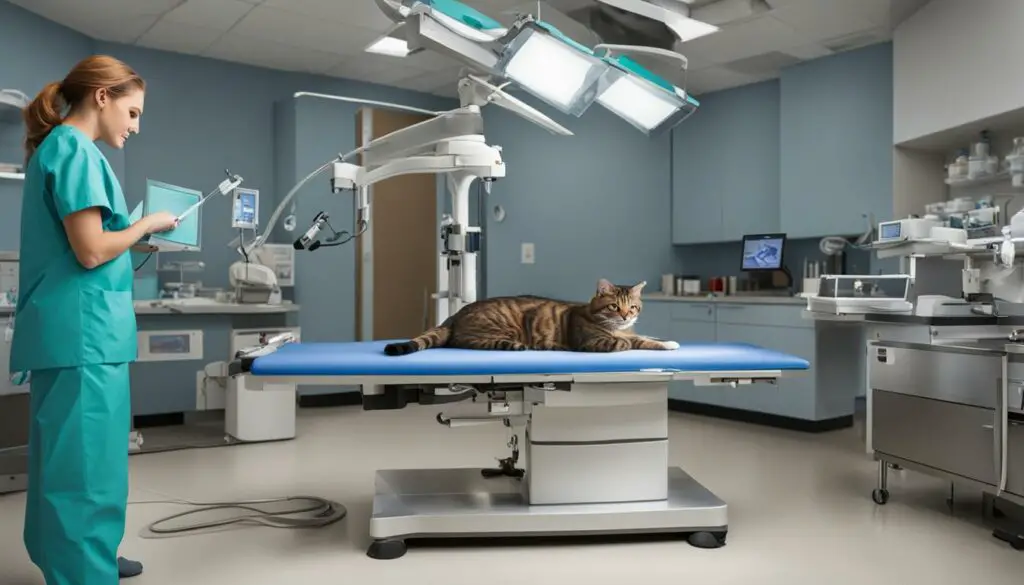
Range of Cat Bladder Stone Surgery Prices
When it comes to cat bladder stone surgery, the cost can vary depending on several factors. These factors include the type of stone, size, location, complexity of the procedure, and the specific treatment approach recommended by the veterinarian. Additionally, geographical location and individual veterinary practices can also influence the overall cost. It is important for pet owners to have a clear understanding of these factors and discuss the potential expenses with their veterinarian to ensure they can make an informed decision.
On average, the cost of cat bladder stone surgery can range from several hundred to several thousand dollars. This wide price range is due to the variability in factors such as stone type, size, and location. To get a more accurate estimate for a specific case, pet owners should consult with their veterinarian, who can provide a detailed breakdown of the expected costs.
It is also worth noting that in addition to the surgical fees, there may be additional costs involved, such as pre-surgical consultations, diagnostic tests, anesthesia fees, medication, hospitalization, and follow-up visits. These additional expenses can further contribute to the overall cost of the procedure.
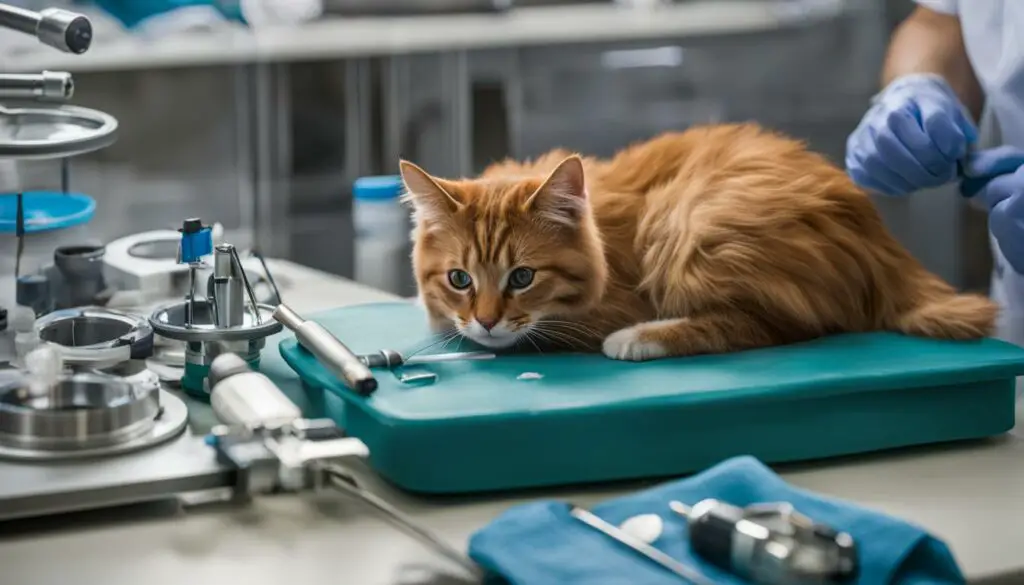
As the cost of cat bladder stone surgery can vary significantly, it is advisable for pet owners to discuss the estimated costs and potential financial implications with their veterinarian. This will allow them to plan and budget accordingly to provide the necessary care for their cat while managing the costs effectively.
Conclusion
In conclusion, understanding the cost of cat bladder stone surgery is crucial for pet owners to make informed decisions about their cat’s healthcare. Bladder stones and crystals can lead to serious health issues, including urinary blockage, which can be life-threatening. Prompt treatment is essential to prevent complications and restore normal urinary function.
The cost of cat bladder stone surgery can vary depending on factors such as the type of stone, size, and location. On average, the price range can range from several hundred to several thousand dollars. It is important for pet owners to discuss the estimated cost with their veterinarian and inquire about available payment options or pet insurance coverage.
Veterinarians can provide detailed cost estimates and help pet owners understand the potential financial implications. Some veterinary practices may offer payment plans or financing options to assist with managing the expenses. Additionally, pet insurance can provide coverage for surgical procedures, including bladder stone removal.
By considering the potential expenses and exploring affordable options, pet owners can ensure the best possible care for their cat while effectively managing the costs. The well-being of our feline companions is priceless, and with proper treatment and management, bladder stones and crystals can be successfully addressed.
FAQ
What are bladder stones and crystals in cat urine?
Bladder stones and crystals are solid waste particles that form in the urine and can lead to urinary blockage, a life-threatening condition for cats.
What is the difference between crystals and bladder stones?
Crystals are the building blocks of bladder stones. When waste products in the urine become concentrated enough to solidify, they can form crystals. These crystals can eventually grow into larger stones.
What are the symptoms of bladder stones and crystals in cat urine?
Symptoms may include increased frequency of urination, straining to urinate, blood in the urine, and urinating outside the litterbox.
What causes bladder stones and crystals in cat urine?
The exact cause is unknown, but factors such as breed, sex, age, diet, and underlying health conditions can play a role.
How do veterinarians diagnose bladder stones and crystals in cat urine?
Diagnosis involves bloodwork, urinalysis, and imaging tests such as X-rays or ultrasound.
What are the treatment options for bladder stones and crystals in cat urine?
Treatment options depend on the type, size, and location of the stones and can include prescription diets, medication, and surgical removal.
How do cats recover from bladder stones and crystals, and what is the long-term management?
Recovery and long-term management involve diet changes, increased water intake, and regular check-ups for potential recurrence.
What is the cost of cat bladder stone surgery?
The cost can vary depending on factors such as the type of stone, size, location, and the specific treatment approach recommended by the veterinarian.
What is the average cost of cat bladder stone surgery?
The average cost can range from several hundred to several thousand dollars, depending on various factors.
What factors can affect the cost of cat bladder stone surgery?
Factors include the type of stone, size, location, complexity of the procedure, specific treatment approach, geographical location, and the individual veterinary practice.
Are there affordable options for cat bladder stone surgery cost?
Some veterinary practices offer payment plans or financing options, and pet insurance can provide coverage for surgical procedures.
What is the range of cat bladder stone surgery prices?
The price range can vary depending on factors such as stone type, size, and location.
Is cat bladder stone surgery cost conclusion?
No, there is no specific conclusion.

